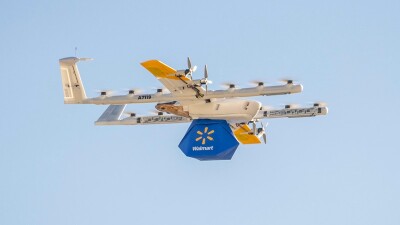We’ve taken a look at what commercial drone opportunities look like across Europe, but that topic and much more are set to be explored in great detail at the upcoming Commercial UAV Expo Europe. The event features a conference program that is designed to highlight the exact ways that professionals in various industries are using drone technology. UAVs in GPS-Denied Tunnels for Crossrail Project, Drones and 3D Models for Aircraft Accident Sites, What Does it Take to Operate BVLOS for Power Line Inspections and Drones as a Service in Agriculture are just a few examples of the education and specific insight that will be showcased at the event.
At a higher level though, what’s the best way for operators to gather industry insights, market data and competitive intelligence? What is the current market situation like? Who are the majors player? These are the exact sort of insights will be explored during the keynote presentation, Commercial UAV Market Trends and Opportunities. Kay Wackwitz is CEO and Founder of Drone Industry Insights, which is the leading market research platform of commercial drones. In anticipation of this upcoming keynote presentation, we caught up with Kay to discuss a few of the topics that will be explored in-depth at that keynote. Those subjects include what commercial UAV opportunities look like from country to country, which trends he’s noticed that few others have picked up on, what professionals can do to stay up-to-date and plenty more.To register for Commercial UAV Expo Europe, click here. Jeremiah Karpowicz: The Drone Industry Insights team is set to deliver the "Commercial UAV Market Trends and Opportunities” presentation at Commercial UAV Expo Europe. What are you hoping attendees will be able to take away from that presentation?Kay Wackwitz: Creating transparency and awareness is the main vehicle to accelerate drone adoption throughout numerous industries. Our insights are bottom-up and based on valid market data - finding trends in these numbers is always very exciting. Over the last few years we discovered how the market gained maturity and see an ongoing consolidation. We see big players entering the field, which is giving this idea a whole new dimension.I hope the attendees will walk away with a more fundamental and solid understanding of the drone market dynamics and a realistic valuation of the chances that lie ahead. Do many of these trends and opportunities vary greatly from country to country in Europe?European-wide regulation is still outstanding, so each country has had to make their own rules in the meantime. These laws vary greatly in substance and possibility, providing very different opportunities for commercial drone operators.In some countries, drone operation is almost impossible. In others (like France, UK, Spain or Norway) the framework is challenging but manageable (comparison: Germany: 81.4M inhabitants - 600+ commercial drone operators; Norway: 5.2M inhabitants - 2.000+ commercial drone operators).The framework unifying all European countries will be released in 2019. Are there any specific opportunities that you’ve been able to identify which relate to a specific industry? That is to say, have you found there to be opportunities in agriculture which are not present for anyone working in construction?There are a lot of parallels and they are - like everything in the drone industry - technology-driven. Comparing different verticals becomes increasingly blurry - one industry discovers a new application and uses an existing solution from another industry. This really drives the quality and the productivity.Currently, I think all solutions/opportunities are available to everyone (depending on regulation of course). It’s a very open community and new accomplishments are being made all the time, which gives everyone the chance to find a solution that fits their niche problem in whatever vertical they happen to be working in. What’s one trend you’ve noticed that not many professionals have caught onto or are aware of?There is a shifting demand on the data. If you do an aerial inspection job, creating 10,000 pictures of a bridge won’t cut it because you can have a high-resolution GIS-referenced 3D model instead, basically without any extra effort. That GIS concept has been spread across various industries. If my drone finds one of my 20,000 solar-panels broken, I want to know exactly where it is and use this data to make repair as efficient as the drone-based inspection.Another thing is workflow-integration. This sounds a bit dry, but actually speaks for the maturity of drone solutions. To let drones be an essential part of the daily business and to integrate aerial data into a company’s value-chain really speaks to a high degree of adoption. There are only a few companies that offer modules and/or complete workflow solutions, but this will change very soon. Is there a specific approach or best practice that you’d recommend for any professional that wants to ensure they’re staying aware of and up-to-date with drone industry trends and opportunities as they arise?I know it’s hard and takes up a lot of valuable time to research and make sense out of the vast amount of solutions that are currently available - but this really seems to be the only way to go. The market moves and changes so quickly, and it’s why being up-to-date is essential to make the right decisions.We do our best to provide a big portfolio of insights and publish them, but most of our research is on-demand and customer specific. We invite everyone with a specific question to reach out and to share our comprehensive view on the drone market to get a better understanding of various industry dynamics and perspectives.
Kay Wackwitz is CEO and Founder of Drone Industry Insights, which is the leading market research platform of commercial drones. In anticipation of this upcoming keynote presentation, we caught up with Kay to discuss a few of the topics that will be explored in-depth at that keynote. Those subjects include what commercial UAV opportunities look like from country to country, which trends he’s noticed that few others have picked up on, what professionals can do to stay up-to-date and plenty more.To register for Commercial UAV Expo Europe, click here. Jeremiah Karpowicz: The Drone Industry Insights team is set to deliver the "Commercial UAV Market Trends and Opportunities” presentation at Commercial UAV Expo Europe. What are you hoping attendees will be able to take away from that presentation?Kay Wackwitz: Creating transparency and awareness is the main vehicle to accelerate drone adoption throughout numerous industries. Our insights are bottom-up and based on valid market data - finding trends in these numbers is always very exciting. Over the last few years we discovered how the market gained maturity and see an ongoing consolidation. We see big players entering the field, which is giving this idea a whole new dimension.I hope the attendees will walk away with a more fundamental and solid understanding of the drone market dynamics and a realistic valuation of the chances that lie ahead. Do many of these trends and opportunities vary greatly from country to country in Europe?European-wide regulation is still outstanding, so each country has had to make their own rules in the meantime. These laws vary greatly in substance and possibility, providing very different opportunities for commercial drone operators.In some countries, drone operation is almost impossible. In others (like France, UK, Spain or Norway) the framework is challenging but manageable (comparison: Germany: 81.4M inhabitants - 600+ commercial drone operators; Norway: 5.2M inhabitants - 2.000+ commercial drone operators).The framework unifying all European countries will be released in 2019. Are there any specific opportunities that you’ve been able to identify which relate to a specific industry? That is to say, have you found there to be opportunities in agriculture which are not present for anyone working in construction?There are a lot of parallels and they are - like everything in the drone industry - technology-driven. Comparing different verticals becomes increasingly blurry - one industry discovers a new application and uses an existing solution from another industry. This really drives the quality and the productivity.Currently, I think all solutions/opportunities are available to everyone (depending on regulation of course). It’s a very open community and new accomplishments are being made all the time, which gives everyone the chance to find a solution that fits their niche problem in whatever vertical they happen to be working in. What’s one trend you’ve noticed that not many professionals have caught onto or are aware of?There is a shifting demand on the data. If you do an aerial inspection job, creating 10,000 pictures of a bridge won’t cut it because you can have a high-resolution GIS-referenced 3D model instead, basically without any extra effort. That GIS concept has been spread across various industries. If my drone finds one of my 20,000 solar-panels broken, I want to know exactly where it is and use this data to make repair as efficient as the drone-based inspection.Another thing is workflow-integration. This sounds a bit dry, but actually speaks for the maturity of drone solutions. To let drones be an essential part of the daily business and to integrate aerial data into a company’s value-chain really speaks to a high degree of adoption. There are only a few companies that offer modules and/or complete workflow solutions, but this will change very soon. Is there a specific approach or best practice that you’d recommend for any professional that wants to ensure they’re staying aware of and up-to-date with drone industry trends and opportunities as they arise?I know it’s hard and takes up a lot of valuable time to research and make sense out of the vast amount of solutions that are currently available - but this really seems to be the only way to go. The market moves and changes so quickly, and it’s why being up-to-date is essential to make the right decisions.We do our best to provide a big portfolio of insights and publish them, but most of our research is on-demand and customer specific. We invite everyone with a specific question to reach out and to share our comprehensive view on the drone market to get a better understanding of various industry dynamics and perspectives. 















Comments